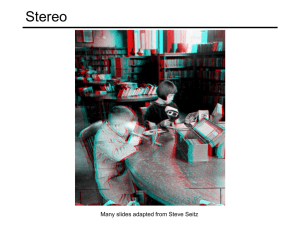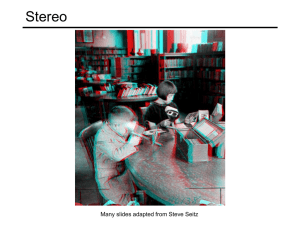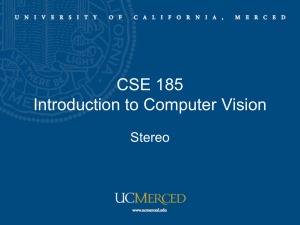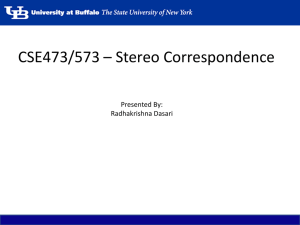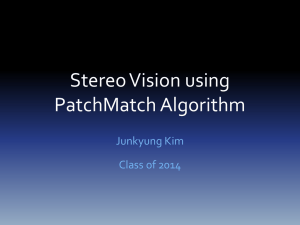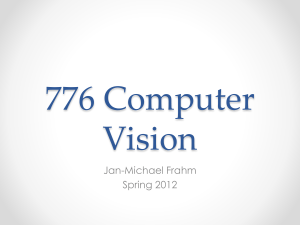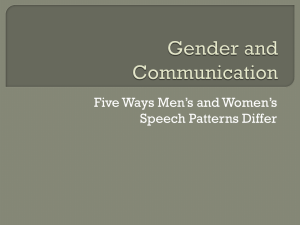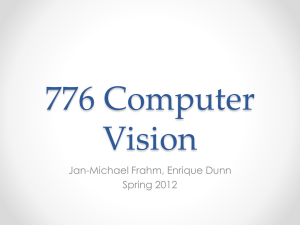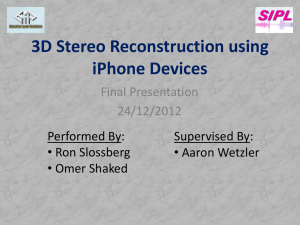PPT - How do I get a website?
advertisement
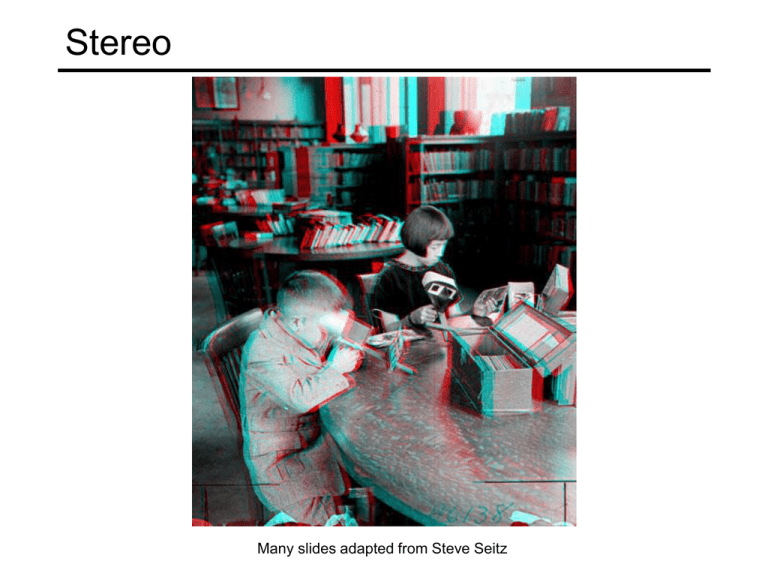
Stereo Many slides adapted from Steve Seitz Binocular stereo • Given a calibrated binocular stereo pair, fuse it to produce a depth image Where does the depth information come from? Binocular stereo • Given a calibrated binocular stereo pair, fuse it to produce a depth image image 1 image 2 Dense depth map Binocular stereo • Given a calibrated binocular stereo pair, fuse it to produce a depth image • Humans can do it Stereograms: Invented by Sir Charles Wheatstone, 1838 Binocular stereo • Given a calibrated binocular stereo pair, fuse it to produce a depth image • Humans can do it Autostereograms: www.magiceye.com Binocular stereo • Given a calibrated binocular stereo pair, fuse it to produce a depth image • Humans can do it Autostereograms: www.magiceye.com Basic stereo matching algorithm • For each pixel in the first image • Find corresponding epipolar line in the right image • Examine all pixels on the epipolar line and pick the best match • Triangulate the matches to get depth information • Simplest case: epipolar lines are corresponding scanlines • When does this happen? Simplest Case: Parallel images • Image planes of cameras are parallel to each other and to the baseline • Camera centers are at same height • Focal lengths are the same Simplest Case: Parallel images • Image planes of cameras are parallel to each other and to the baseline • Camera centers are at same height • Focal lengths are the same • Then, epipolar lines fall along the horizontal scan lines of the images Essential matrix for parallel images Epipolar constraint: x E x 0, E [ t ] R T R=I x x’ t u v 0 1 0 0 0 0 T 0 u T v 0 0 1 t = (T, 0, 0) 0 E [ t ] R 0 0 u v 0 1 T Tv 0 0 T 0 0 T 0 T v Tv The y-coordinates of corresponding points are the same! Depth from disparity X z x’ x f O disparity f Baseline B x x O’ B f z Disparity is inversely proportional to depth! Stereo image rectification Stereo image rectification • • • reproject image planes onto a common plane parallel to the line between optical centers pixel motion is horizontal after this transformation two homographies (3x3 transform), one for each input image reprojection C. Loop and Z. Zhang. Computing Rectifying Homographies for Stereo Vision. IEEE Conf. Computer Vision and Pattern Recognition, 1999. Rectification example Correspondence search Left Right scanline Matching cost disparity • Slide a window along the right scanline and compare contents of that window with the reference window in the left image • Matching cost: SSD or normalized correlation Correspondence search Left Right scanline SSD Correspondence search Left Right scanline Norm. corr Basic stereo matching algorithm • If necessary, rectify the two stereo images to transform epipolar lines into scanlines • For each pixel x in the first image • Find corresponding epipolar scanline in the right image • Examine all pixels on the scanline and pick the best match x’ • Compute disparity x-x’ and set depth(x) = B*f/(x-x’) Failures of correspondence search Textureless surfaces Occlusions, repetition Non-Lambertian surfaces, specularities Effect of window size W=3 • Smaller window + More detail – More noise • Larger window + Smoother disparity maps – Less detail W = 20 Results with window search Data Window-based matching Ground truth Better methods exist... Graph cuts Ground truth Y. Boykov, O. Veksler, and R. Zabih, Fast Approximate Energy Minimization via Graph Cuts, PAMI 2001 For the latest and greatest: http://www.middlebury.edu/stereo/ How can we improve window-based matching? • The similarity constraint is local (each reference window is matched independently) • Need to enforce non-local correspondence constraints Non-local constraints • Uniqueness • For any point in one image, there should be at most one matching point in the other image Non-local constraints • Uniqueness • For any point in one image, there should be at most one matching point in the other image • Ordering • Corresponding points should be in the same order in both views Non-local constraints • Uniqueness • For any point in one image, there should be at most one matching point in the other image • Ordering • Corresponding points should be in the same order in both views Ordering constraint doesn’t hold Non-local constraints • Uniqueness • For any point in one image, there should be at most one matching point in the other image • Ordering • Corresponding points should be in the same order in both views • Smoothness • We expect disparity values to change slowly (for the most part) Scanline stereo • Try to coherently match pixels on the entire scanline • Different scanlines are still optimized independently Left image Right image “Shortest paths” for scan-line stereo Left image I Right image I S left Right occlusion C occl Left occlusion q t s p S right C occl C corr Can be implemented with dynamic programming Ohta & Kanade ’85, Cox et al. ‘96 Slide credit: Y. Boykov Coherent stereo on 2D grid • Scanline stereo generates streaking artifacts • Can’t use dynamic programming to find spatially coherent disparities/ correspondences on a 2D grid Stereo matching as energy minimization I2 I1 E (D) D W1(i) W2(i+D(i)) W ( i ) W 2 ( i D ( i )) 2 1 i D(i) D (i ) D ( j ) neighbors i , j data term smoothness term • Energy functions of this form can be minimized using graph cuts Y. Boykov, O. Veksler, and R. Zabih, Fast Approximate Energy Minimization via Graph Cuts, PAMI 2001 Active stereo with structured light • Project “structured” light patterns onto the object • Simplifies the correspondence problem • Allows us to use only one camera camera projector L. Zhang, B. Curless, and S. M. Seitz. Rapid Shape Acquisition Using Color Structured Light and Multi-pass Dynamic Programming. 3DPVT 2002 Active stereo with structured light L. Zhang, B. Curless, and S. M. Seitz. Rapid Shape Acquisition Using Color Structured Light and Multi-pass Dynamic Programming. 3DPVT 2002 Active stereo with structured light http://en.wikipedia.org/wiki/Structured-light_3D_scanner Kinect: Structured infrared light http://bbzippo.wordpress.com/2010/11/28/kinect-in-infrared/ Laser scanning Digital Michelangelo Project Levoy et al. http://graphics.stanford.edu/projects/mich/ Optical triangulation • Project a single stripe of laser light • Scan it across the surface of the object • This is a very precise version of structured light scanning Source: S. Seitz Laser scanned models The Digital Michelangelo Project, Levoy et al. Source: S. Seitz Laser scanned models The Digital Michelangelo Project, Levoy et al. Source: S. Seitz Laser scanned models The Digital Michelangelo Project, Levoy et al. Source: S. Seitz Laser scanned models The Digital Michelangelo Project, Levoy et al. Source: S. Seitz Laser scanned models 1.0 mm resolution (56 million triangles) The Digital Michelangelo Project, Levoy et al. Source: S. Seitz Aligning range images • A single range scan is not sufficient to describe a complex surface • Need techniques to register multiple range images B. Curless and M. Levoy, A Volumetric Method for Building Complex Models from Range Images, SIGGRAPH 1996 Aligning range images • A single range scan is not sufficient to describe a complex surface • Need techniques to register multiple range images … which brings us to multi-view stereo
